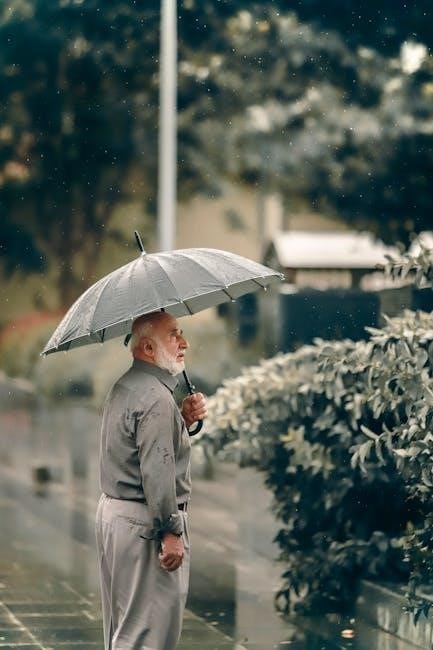Leslie Marmon Silko’s poignant short story, published in 1968, explores cultural conflict and tradition through a Native American family’s experience with death and burial rituals.
1.1 Overview of the Short Story
The Man to Send Rain Clouds, by Leslie Marmon Silko, is a poignant tale exploring cultural conflict and tradition. The story centers on the death of Teofilo, an elderly Laguna Pueblo man, and his family’s efforts to honor him through traditional burial rituals. Set in the Southwest, it vividly portrays the clash between Native American customs and Catholic practices, highlighting themes of identity, religion, and the struggle to preserve heritage in a modernizing world. The narrative is both a tribute to tradition and a reflection on cultural resilience.
1.2 Author Background: Leslie Marmon Silko
Leslie Marmon Silko, a celebrated Laguna Pueblo writer, was born in 1948 in Albuquerque, New Mexico. Her work often explores the intersection of Native American traditions and modernity. Silko’s writing is deeply rooted in her Laguna Pueblo heritage, reflecting themes of cultural identity and resilience. Educated at the University of New Mexico, she gained acclaim for her storytelling, which blends oral traditions with contemporary narratives. Her work has been recognized with numerous awards, solidifying her role as a prominent voice in Native American literature.
1.3 Historical Context of the Story
The Man to Send Rain Clouds is set in the Southwest, a region rich in cultural diversity due to its complex colonial history. The story reflects the legacy of colonialism and the blending of Native American traditions with Catholicism. The Laguna Pueblo people, like many Native communities, faced cultural suppression and religious imposition, leading to a struggle between preserving ancient rituals and adapting to external influences. This historical backdrop underscores the story’s themes of cultural conflict and resilience.
Plot Summary
The Man to Send Rain Clouds follows the discovery of Teofilo’s body under a cottonwood tree and the subsequent preparations for his burial by his family, blending tradition and conflict.
2.1 The Discovery of Teofilo’s Body
Teofilo, a Laguna Pueblo elder, is found deceased under a large cottonwood tree. His faded Levi jacket and pants make him easily visible. The discovery sparks a series of events as his grandsons, Leon and Ken, begin preparing for his burial. The cottonwood tree, a symbol of cultural significance, sets the scene for the blending of traditional and modern practices. This moment marks the beginning of the family’s journey to honor Teofilo according to their heritage.
2.2 Preparations for the Burial
Leon and Ken, Teofilo’s grandsons, prepare his body for burial, adhering to Laguna Pueblo traditions. They paint his face with yellow ochre and green, symbolizing life and spiritual renewal. The brothers gather materials, including sage and a cottonwood branch, to honor their ancestor. Their meticulous preparations reflect deep respect for cultural customs, even as they navigate the influence of modernity and external pressures, such as the presence of a Catholic priest, who represents a different set of beliefs.
2.3 The Clash of Traditions
The story highlights a profound clash between Native American traditions and Catholicism. The Laguna Pueblo family secretly performs a traditional burial, deceiving the young Catholic priest. This tension reflects broader cultural conflicts, as indigenous customs struggle to coexist with imposed religious practices. Silko’s narrative underscores the resilience of Native traditions and the challenges of maintaining cultural identity in a rapidly changing world, emphasizing the enduring importance of ancestral rituals despite external pressures.
Themes in “The Man to Send Rain Clouds”
Cultural conflict, religious traditions, and the struggle between modernity and heritage are central themes, exploring identity, death rituals, and the clash of indigenous and Catholic practices.
3.1 Cultural Conflict and Identity
Cultural conflict and identity are central to the story, as the Laguna Pueblo people navigate their traditional beliefs and the influence of Catholicism. The clash between these two worlds is evident in the burial rituals, where the family honors Teofilo with both tribal customs and Catholic practices. This duality reflects the broader struggle of Native American communities to preserve their heritage while adapting to external pressures. The story highlights the tension between cultural identity and the forces of modernity, emphasizing the importance of tradition in shaping individual and communal identity.
3.2 Religion and Tradition
Religion and tradition play pivotal roles in the story, as the Laguna Pueblo family balances their ancestral practices with Catholic influences. The narrative highlights the coexistence of these two belief systems, particularly through the burial rituals. The family adheres to their tribal customs, such as painting Teofilo’s face and sending rain clouds, while also involving the Catholic priest. This blend of traditions underscores the tension between preserving cultural heritage and adapting to external religious practices, reflecting the broader experiences of Native American communities in maintaining their identities amidst colonial and religious influences.
3.3 The Struggle Between Modernity and Tradition
The clash between modernity and tradition is central to the story, as the Laguna Pueblo family navigates the demands of contemporary life while honoring ancient customs. The younger generation, represented by Leon and Ken, embodies this struggle, blending traditional practices with modern realities. Their efforts to deceive the Catholic priest while conducting a traditional burial reflect the tension between adhering to cultural roots and adapting to external influences. This conflict highlights the enduring relevance of indigenous traditions in a rapidly changing world, emphasizing the importance of preserving cultural identity.
3.4 Death and Mourning Rituals
Death and mourning rituals play a pivotal role in the story, as Teofilo’s passing prompts a traditional Laguna Pueblo burial. The family meticulously prepares his body, painting his face with symbolic colors to honor his spirit. The discovery of his body under a cottonwood tree and the subsequent rituals underscore the community’s deep respect for their ancestors. These customs highlight the importance of spiritual continuity, bridging the gap between the deceased and the living while reflecting the enduring cultural identity of the Laguna Pueblo people.
Cultural Significance
The Man to Send Rain Clouds highlights the importance of preserving indigenous traditions and the resilience of Native American cultures in the face of colonial influence, offering a vital perspective on cultural identity and heritage.
4.1 Native American Traditions in the Story
The story vividly portrays Native American traditions, such as the ritualistic burial of Teofilo, emphasizing the importance of ancestral customs and the belief in the spiritual connection between nature and humanity. The Laguna Pueblo people’s practices, including the use of symbolic colors and the invocation of rain clouds, highlight their deep-rooted cultural heritage and the significance of maintaining these traditions in the face of external influences. These elements serve as a testament to the enduring legacy of indigenous customs.
4.2 The Role of the Laguna Pueblo People
The Laguna Pueblo people play a central role in the story, showcasing their resilience and cultural identity. They navigate the complexities of preserving their traditions while facing external influences; The community’s collective effort to honor Teofilo’s burial reflects their deep connection to ancestral practices and the land. Their actions highlight the importance of cultural preservation and the enduring strength of indigenous identity in a rapidly changing world. The Laguna Pueblo’s traditions serve as a testament to their rich heritage and communal resilience.
4.3 The Impact of Catholicism on Native Cultures
Catholicism’s influence on Native cultures is evident through its clash with traditional practices, as seen in the story. The Laguna Pueblo community deceives the Catholic priest to honor their elder’s burial rites, reflecting resistance to religious assimilation. This tension highlights the enduring struggle between indigenous traditions and imposed Catholic beliefs. The story underscores how Catholicism has shaped, yet often conflicted with, Native cultural identity, leading to a complex blend of spiritual practices and cultural resilience. This dynamic remains a significant theme in understanding Native American experiences.

Character Analysis
Teofilo, the elder, symbolizes cultural heritage, while Leon and Ken embody the struggle between tradition and modernity. The Catholic priest represents external influences on Native identity and rituals.
5.1 Teofilo: The Elder and His Significance
Teofilo, the elderly Laguna Pueblo man, is found dead under a cottonwood tree, symbolizing his deep connection to nature and tradition. His death sparks a clash between modern and indigenous burial customs, as his family seeks to honor his legacy through ancestral rituals. Teofilo embodies the resilience of Native American culture, while his passing underscores the tension between preserving heritage and adapting to external influences, making him a central figure in the story’s exploration of identity and tradition.
5.2 Leon and Ken: The Brothers-in-Law
Leon and Ken, Teofilo’s grandsons, are central to the story as they navigate the complexities of honoring their grandfather’s legacy. Their actions reflect the tension between tradition and modernity, as they prepare for Teofilo’s burial while engaging with the Catholic priest. Leon’s quiet determination and Ken’s practicality highlight their distinct personalities, while their shared goal of respecting Teofilo’s traditions underscores their deep cultural connection. Their interactions reveal the challenges of maintaining indigenous practices in a changing world.
5.3 The Catholic Priest: A Symbol of Conflict
The Catholic priest in the story embodies the clash between tradition and modernity, representing the imposition of Catholicism on Native American culture. His insistence on performing a Christian burial highlights the tension between indigenous rituals and colonial religious practices. The community’s deception of the priest underscores their resistance to cultural erasure, while his presence symbolizes the historical impact of colonialism on Native traditions. His role in the narrative serves as a poignant reminder of the ongoing struggle for cultural preservation and identity.
Symbolism in the Story
The cottonwood tree, rain clouds, and ritual colors symbolize cultural heritage, spiritual renewal, and the enduring legacy of Laguna Pueblo traditions in the story;
6.1 The Cottonwood Tree as a Symbol
The cottonwood tree in the story symbolizes cultural heritage and spiritual renewal. It stands apart from others, mirroring Teofilo’s isolated yet profound connection to tradition. The tree’s presence during the discovery of his body and the subsequent burial rituals underscores its significance as a bridge between the physical and spiritual worlds. Its endurance and solitude reflect the resilience of Laguna Pueblo traditions in the face of modernity and cultural change, embodying the story’s central themes of identity and legacy.
6.2 The Rain Clouds and Their Spiritual Meaning
Rain clouds in the story symbolize spiritual renewal and the enduring connection to ancestors. The Laguna Pueblo people believe rain brings life and cleanses the spirit, reflecting their deep bond with nature. Teofilo’s death prompts the community to pray for rain, seeking divine intervention to honor his memory. This act embodies the tension between tradition and modernity, while also highlighting the tribe’s reverence for natural elements and their spiritual significance in preserving cultural identity and continuity. The rain clouds thus serve as a metaphor for hope and renewal.
6.3 The Use of Colors in Rituals
Colors play a symbolic role in the story’s rituals, reflecting the Laguna Pueblo’s spiritual beliefs. Yellow paint, applied under the deceased’s nose, signifies protection and the sun’s life-giving power. Green, used across the chin, represents renewal and the natural world. These vibrant hues contrast with the faded blue of Teofilo’s clothing, symbolizing the blending of tradition and modernity. The rituals emphasize the tribe’s deep connection to their cultural identity and the spiritual significance of colors in honoring the dead and ensuring ancestral continuity. This tradition highlights resilience and cultural preservation.
Literary Devices and Style
Silko’s narrative technique masterfully blends vivid imagery with subtle dialogue, creating an immersive experience. Her descriptive language emphasizes cultural traditions, while the sparse, direct dialogue reflects the characters’ stoicism and deep-rooted beliefs, enhancing the story’s emotional depth and authenticity.
7.1 Silko’s Narrative Technique
Silko’s narrative technique in “The Man to Send Rain Clouds” is marked by simplicity and subtlety. She employs sparse, direct dialogue to convey the quiet strength and resilience of her characters. The story’s vivid imagery, particularly in describing the natural landscape and cultural rituals, creates a rich sensory experience. Silko’s prose reflects the pacing of traditional oral storytelling, blending past and present seamlessly. Her approach emphasizes cultural authenticity, allowing the reader to witness the intricate balance between tradition and modernity through the eyes of the Laguna Pueblo people.
7.2 The Use of Imagery and Description
Silko’s use of imagery and description in “The Man to Send Rain Clouds” enriches the narrative, immersing readers in the cultural and physical landscape. The cottonwood tree, Teofilo’s faded clothing, and the arroyo’s sandy terrain are vividly depicted, creating a stark yet evocative setting. These descriptions not only establish the story’s atmosphere but also reflect the deepest cultural and spiritual connections of the Laguna Pueblo people, embedding their traditions and beliefs into the natural world.
7.3 Dialogue and Character Development
Dialogue in “The Man to Send Rain Clouds” plays a crucial role in revealing character traits and cultural tensions. Through sparse yet meaningful conversations, Silko highlights the internal and external conflicts faced by Leon, Ken, and the Catholic priest. The dialogue underscores the clash between tradition and modernity, as the Laguna Pueblo family navigates their cultural identity. Leon’s quiet determination and Ken’s practicality are evident in their exchanges, while the priest’s limited understanding of Native traditions adds depth to the narrative. The conversations are concise but powerful, driving the story’s emotional and thematic resonance.

Historical and Anthropological Insights
The story reflects the Southwest’s cultural blending, highlighting historical interactions between Native traditions and external influences, with colonialism’s legacy shaping community dynamics and identity.
8.1 The Southwest as a Cultural Melting Pot
The Southwest, with its rich history, serves as a cultural melting pot where Native American, Hispanic, and European traditions intersect. Leslie Marmon Silko’s story highlights this blending, particularly through the Laguna Pueblo people’s experiences. The region’s colonial past and the influx of external influences have created a unique cultural landscape. The narrative underscores how these diverse traditions coexist, often leading to tension and adaptation, as seen in the clash between Native rituals and Catholic practices, reflecting the broader historical context of the Southwest.
8.2 The Legacy of Colonialism in Native Communities
The legacy of colonialism in Native communities is evident in the imposition of external beliefs and practices. Silko’s story illustrates the clash between indigenous traditions and Catholicism, as seen in the deception of the priest. This reflects the broader historical impact of colonialism, where Native cultures faced suppression. The narrative underscores the resilience of indigenous traditions, highlighting the ongoing struggle for cultural preservation and identity amidst colonial influences.
8.3 The Importance of Preserving Indigenous Traditions
Preserving indigenous traditions is vital for maintaining cultural identity and community continuity. In “The Man to Send Rain Clouds,” the family’s adherence to tribal burial rituals highlights the significance of honoring ancestral practices. This preservation not only maintains cultural heritage but also serves as a form of resistance against cultural erasure. Silko’s story emphasizes the enduring importance of indigenous traditions in a world increasingly influenced by external forces.

Reception and Critical Analysis
Leslie Marmon Silko’s “The Man to Send Rain Clouds” has received critical acclaim for its exploration of cultural conflict and enduring relevance in American literature.
9.1 Initial Reception of the Story
The Man to Send Rain Clouds was first published in 1968 under Leslie Marmon Silko’s maiden name, Leslie Chapman, and quickly gained attention for its poignant portrayal of cultural conflict. Critics praised its nuanced exploration of Native American traditions and the clash with Catholicism. The story’s inclusion in the 1974 anthology Contemporary Stories by American Indians further solidified its reputation. Its initial reception highlighted its ability to bridge cultural divides, earning acclaim for its depth and authenticity, and it remains a celebrated work in American literature.
9;2 Scholarly Interpretations and Essays
Scholars have widely interpreted The Man to Send Rain Clouds as a powerful exploration of cultural conflict and identity. Essays highlight the story’s nuanced portrayal of the clash between Native American traditions and Catholicism, emphasizing the tension between modernity and heritage. The deception of the Catholic priest has been analyzed as a symbol of resistance and cultural preservation. Many academic writings explore the story’s deeper themes, such as the struggle to maintain indigenous practices in a colonized world, further cementing its significance in American literary studies.
9.3 The Story’s Place in American Literature
The Man to Send Rain Clouds holds a significant place in American literature as a cornerstone of Native American storytelling. Its exploration of cultural identity and religious conflict resonates deeply, making it a vital text in multicultural studies. The story’s ability to blend traditional Laguna Pueblo traditions with modern influences has solidified its reputation as a groundbreaking work. It continues to be celebrated for its nuanced portrayal of indigenous experiences, ensuring its enduring relevance in the literary canon.
Educational and Pedagogical Value
The Man to Send Rain Clouds is a valuable educational tool for exploring cultural identity, tradition, and conflict. It fosters discussions on multiculturalism and indigenous perspectives.
10.1 Teaching the Story in Classrooms
The Man to Send Rain Clouds is widely used in educational settings to explore cultural identity, tradition, and conflict. Teachers incorporate it into lesson plans to foster discussions on multiculturalism, indigenous traditions, and religious clashes. The story’s themes of death rituals and family dynamics encourage critical thinking about modern vs. traditional values. Its concise narrative makes it ideal for analyzing literary devices and cultural symbolism, engaging students in reflective conversations about identity and heritage.
10.2 Lesson Plans and Study Guides
Educators often use PDF versions of The Man to Send Rain Clouds to create detailed lesson plans. These resources include discussion guides, essay prompts, and cultural context analyses. Many study guides focus on themes like identity, tradition, and religious conflict, offering activities to deepen students’ understanding. Teachers also incorporate historical and anthropological insights to enrich discussions, making the story a powerful tool for multicultural education and critical thinking about cultural preservation and modernity. These materials are widely available online for classroom use.
10.3 The Story’s Role in Multicultural Education
The Man to Send Rain Clouds plays a significant role in multicultural education by offering insights into Native American traditions and cultural identity. The story bridges gaps between indigenous and Western perspectives, fostering cross-cultural understanding. Its exploration of religious and cultural clashes resonates in diverse classrooms, encouraging discussions on identity, colonialism, and tradition. Educators use the story to teach empathy and the importance of preserving cultural heritage, making it a vital tool for promoting inclusivity and respect for diverse traditions in educational settings.

Availability and Access
The Man to Send Rain Clouds is widely available in anthologies like Contemporary Stories by American Indians and as a downloadable PDF online, ensuring easy access for readers and educators.
11.1 The Story in Anthologies and Collections
The Man to Send Rain Clouds is featured in various anthologies, including Contemporary Stories by American Indians, edited by Kenneth Rosen, and other multicultural collections. These anthologies highlight its cultural significance and accessibility to a broad audience. The story’s inclusion in such compilations underscores its importance in Native American literature and its relevance to themes of identity and tradition. This widespread availability ensures its reach among readers and scholars alike, making it a staple in academic and literary circles.
11;2 Digital Versions and PDF Availability
The Man to Send Rain Clouds is widely available in digital formats, including PDF, through various academic and literary platforms. Websites like enotes.com and educational databases offer downloadable versions, making it accessible for students and researchers. Its inclusion in digital anthologies further enhances its reach, ensuring that readers can easily access this significant work of Native American literature. This convenience has made the story a popular choice for classrooms and personal reading, fostering broader engagement with its themes and cultural insights.
11.3 Audio and Visual Adaptations
While primarily circulated as a written work, The Man to Send Rain Clouds has inspired various audio and visual interpretations. Audio readings of the story are available online, offering listeners a deeper connection to its emotional depth. Visual adaptations, such as illustrated versions or short films, enhance the narrative’s cultural and symbolic elements. These formats make the story accessible to a broader audience, preserving its themes of tradition and cultural identity for modern engagement and reflection.
The Man to Send Rain Clouds remains a powerful exploration of cultural identity and tradition, offering timeless insights into conflicts and resolutions in a changing world.
12.1 The Enduring Relevance of the Story
The Man to Send Rain Clouds remains a significant work in American literature, offering insights into cultural identity and tradition. Its exploration of conflicts between Native American customs and Catholicism resonates universally, highlighting struggles of cultural preservation. The story’s themes of loss, tradition, and resilience continue to captivate readers, making it a vital text for understanding multicultural dynamics. Its enduring relevance lies in its ability to bridge past and present, fostering dialogue on identity and heritage.
12.2 Final Thoughts on Cultural Conflict and Resolution
The Man to Send Rain Clouds poignantly illustrates the universal struggle between tradition and modernity, offering a nuanced exploration of cultural conflict; Silko’s narrative highlights the tension between Native American customs and Catholicism, ultimately revealing the resilience of indigenous traditions. The story’s resolution lies in the blending of practices, showing that cultural harmony can emerge from mutual respect and understanding. This timeless theme resonates globally, underscoring the importance of preserving heritage while embracing change, offering hope for coexistence in a diverse world.
